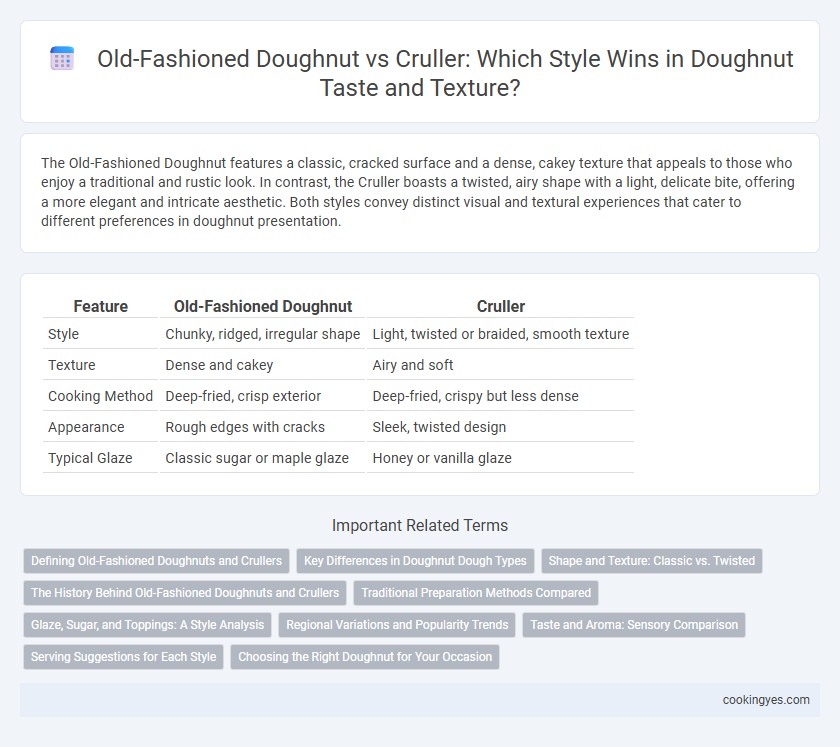The Old-Fashioned Doughnut features a classic, cracked surface and a dense, cakey texture that appeals to those who enjoy a traditional and rustic look. In contrast, the Cruller boasts a twisted, airy shape with a light, delicate bite, offering a more elegant and intricate aesthetic. Both styles convey distinct visual and textural experiences that cater to different preferences in doughnut presentation.
Table of Comparison
| Feature | Old-Fashioned Doughnut | Cruller |
|---|---|---|
| Style | Chunky, ridged, irregular shape | Light, twisted or braided, smooth texture |
| Texture | Dense and cakey | Airy and soft |
| Cooking Method | Deep-fried, crisp exterior | Deep-fried, crispy but less dense |
| Appearance | Rough edges with cracks | Sleek, twisted design |
| Typical Glaze | Classic sugar or maple glaze | Honey or vanilla glaze |
Defining Old-Fashioned Doughnuts and Crullers
Old-Fashioned Doughnuts feature a cracked, ridged surface and a dense, cake-like texture, typically made with a thick batter containing baking soda to achieve their signature crisp exterior. Crullers are characterized by their twisted, braided shape, often made from a light, airy pate a choux dough that results in a tender, hollow crumb. The distinct preparation methods highlight the Old-Fashioned doughnut's rustic, hearty style versus the Cruller's delicate, elegant form.
Key Differences in Doughnut Dough Types
Old-fashioned doughnuts feature a thick, cake-like texture made from a chemically leavened batter with baking powder or baking soda. In contrast, crullers use a light, airy choux pastry dough that puffs up when fried, creating a distinctive hollow center and a tender interior. The key difference lies in the dough composition, where old-fashioned doughnuts are dense and crumbly, while crullers are crisp on the outside but soft and airy inside.
Shape and Texture: Classic vs. Twisted
The Old-Fashioned doughnut features a rough, cracked surface with a distinctive irregular ring shape, offering a crispy exterior and dense, cakey texture. In contrast, the cruller boasts a twisted, braided form that results in a lighter, airy texture with a smooth, glazed finish. Both styles emphasize unique shape and texture, with the Old-Fashioned highlighting rustic simplicity and the cruller showcasing delicate intricacy.
The History Behind Old-Fashioned Doughnuts and Crullers
Old-Fashioned Doughnuts trace back to early 19th-century America, known for their dense texture and cracked, crispy exterior, often fried in pork fat for a rich flavor. Crullers originated from Dutch settlers, characterized by their twisted, airy shape and light, honey-glazed finish, reflecting European pastry traditions. Both doughnut styles showcase distinct cultural heritages and evolving frying techniques that highlight their unique textures and flavors.
Traditional Preparation Methods Compared
Old-Fashioned doughnuts maintain a dense, cake-like texture achieved through a traditional creaming method that blends butter and sugar before adding dry ingredients, preserving a classic flavor profile. Crullers utilize a choux pastry technique, which involves cooking the dough on the stovetop prior to frying, resulting in a light, airy interior with a distinctively twisted shape. Both styles emphasize time-honored frying methods at moderate oil temperatures to ensure a crispy exterior without overpowering greasiness.
Glaze, Sugar, and Toppings: A Style Analysis
Old-Fashioned doughnuts feature a dense, cake-like texture with a cracked surface that holds glaze and sugar toppings effectively, creating a rich, crunchy exterior. Crullers, characterized by their twisted, airy structure, absorb glazes evenly and showcase toppings like powdered sugar with a lighter, fluffier finish. The choice between the two hinges on preferred texture and the visual appeal of glaze distribution and topping adherence for a distinct style experience.
Regional Variations and Popularity Trends
Old-Fashioned doughnuts, known for their crispy edges and cakey interior, are particularly popular in the Midwest and Northeast regions of the United States, often favored during fall and winter seasons. Crullers, with their light, airy texture and twisted shape, hold strong popularity in New England and parts of Canada, especially in coffee shops and bakeries during breakfast hours. Regional preferences highlight Old-Fashioned doughnuts' association with traditional, hearty flavors, while crullers attract consumers seeking a delicate pastry experience, reflecting evolving trends in local taste profiles.
Taste and Aroma: Sensory Comparison
Old-Fashioned Doughnuts feature a dense, cake-like texture with a deep, buttery flavor and a slightly crispy exterior that enhances a rich, sweet aroma. Crullers offer a lighter, airy bite with a tender, twisted shape that accentuates a delicate vanilla scent and subtle sweetness. Both provide unique sensory experiences, where Old-Fashioned Doughnuts emphasize robustness and a comforting taste, while Crullers highlight lightness and fragrant pleasure.
Serving Suggestions for Each Style
Old-Fashioned doughnuts pair perfectly with coffee or hot chocolate, often served glazed or with a dusting of powdered sugar to enhance their crunchy texture. Crullers, known for their light and airy texture, are best enjoyed fresh and glazed, making them an ideal accompaniment to tea or fruit preserves. Serving Old-Fashioned doughnuts warm accentuates their crispy exterior, while crullers maintain their delicate softness when served at room temperature.
Choosing the Right Doughnut for Your Occasion
Old-Fashioned doughnuts feature a dense, cake-like texture with a crisp, cracked exterior, ideal for classic breakfast settings or nostalgic celebrations. Crullers offer a light, airy, and twisted shape with a tender interior, making them perfect for elegant tea parties or sophisticated gatherings. Choosing between Old-Fashioned and Cruller doughnuts depends on the desired texture and presentation that best complements the event's atmosphere and guest preferences.
Old-Fashioned Doughnut vs Cruller for Style Infographic

 cookingyes.com
cookingyes.com